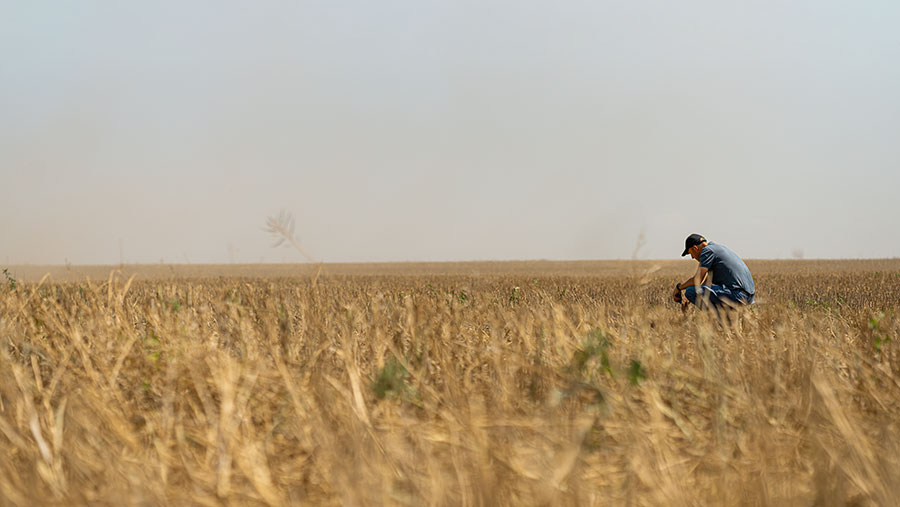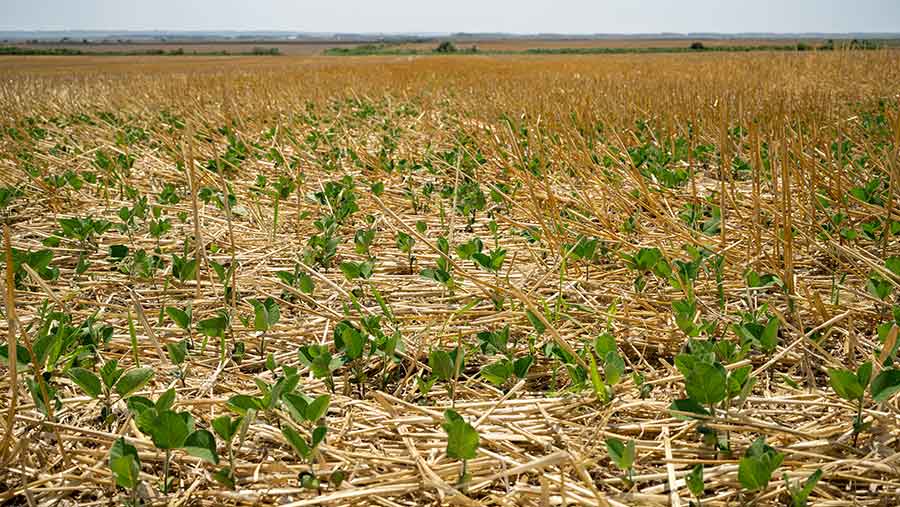Advertiser content
Soil carbon credits are key to unlocking agricultural wealth
 © Agreena
© Agreena In today’s world, where the effects of climate change and the importance of soil health are becoming more evident, the concept of soil carbon credits has gained prominence.
But what is a soil carbon credit and how can farms generate and use them?
Regenerative farming has been shown to boost the amount of carbon stored in soils.
In fact, it is estimated that if just under half of the land that is currently available for regenerative agriculture were to transition, it could result in a total reduction of 23 gigatonnes of carbon dioxide equivalent (CO2e) by 2050 – according to research from Project Drawdown.
Soil carbon programmes issue credits to farmers as a way of encouraging these regenerative practices – but what are ‘credits’ and why should you care about them?
Let’s start by identifying what a soil carbon credit is. Simply put, a soil carbon credit represents one metric tonne of CO2e reduced, or removed from the atmosphere by soil-based mechanisms.
Farmers who take part in soil carbon programmes can earn credits for the CO2 reduced and removed due to transitioning to regenerative practices.
Companies can then financially support these farmers as they transition by purchasing their credits in the carbon market.
In turn, the credits help the companies compensate for their hard-to-abate emissions.

© Agreena
Carbon markets explained
Carbon credits are traded on carbon markets. There are two types of carbon market: compliance carbon markets (CCMs) and voluntary carbon market (VCM).
The CCMs are carbon markets that are regulated by mandatory regional, national or international governmental regimes.
The VCM is where carbon credits are purchased, usually by organisations, for voluntary use rather than to comply with legally binding emissions reduction obligations.
Buyers are usually purchasing carbon credits on the VCM to compensate for their own hard-to-abate greenhouse gas (GHG) emissions. The VCM is where Agreena’s soil carbon credits are traded.
In order to generate carbon credits that can be sold on the VCM, a project developer has to adhere to standards and methodologies that assure the buyer of the climate impact being claimed.
The prices of carbon credits traded on the VCM are primarily determined by supply-and-demand dynamics, carbon credit quality and market sentiment.
The soil carbon connection
Farmers can play a crucial role in the generation of soil carbon credits by moving away from conventional farming practices to more regenerative ones – such as minimum/no soil disturbance, planting cover crops, and optimising organic fertilisers and residue management.
Agreena’s soil carbon programme, AgreenaCarbon, validates the greenhouse gas (GHG) reductions and carbon removals that result from these practices and issues credits to farmers based on the results.
Farmers earn one carbon credit for each tonne of CO2e taken out of the atmosphere and stored in the soil, or reduced, through their regenerative practices.
The calculated emissions reductions and removals are verified through the AgreenaCarbon dMRV (digital Measurement, Reporting and Verification) approach.
This includes in-house, satellite-driven technology and machine-learning-based models, which help automate the monitoring of field practices and progression.
The data collected is then third-party verified by a validation and verification body, and independent auditors.
Various standards and verification schemes have been developed to help provide reassurance on the quality of carbon credits.
When you sign up for the AgreenaCarbon programme, your baseline (what would happen if you continued with business as usual) is calculated following submission of historic practices on the chosen fields and verified using the AgreenaCarbon dMRV approach and technology.
Depending on the field’s specific circumstances (i.e. ownership versus leasing, availability of sufficient and detailed historic practice data), AgreenaCarbon then generates value for the transition to regenerative practices using the appropriate carbon credit methodology.
This makes the value of the credits attractive to buyers due to their credibility and the assurance that carbon impacts are genuine and verifiable.
The credits are made available and sold through a public registry for full transparency and traceability.
The farmers themselves decide whether to keep or sell the credits earned. Agreena even helps them find the best market price available.
Who buys soil carbon credits?
In recent years, there has been a surge in demand for high-integrity carbon credits within the VCM.
The buyers of these credits are diverse and include corporations, governments, NGOs and individuals seeking to compensate for their own hard-to-abate GHG emissions and contribute to climate change mitigation actions.
Investing in carbon credits supports external emission reduction or removal projects, whereas investing in carbon insets focuses on internal emission reductions within a stakeholder’s own value chain.
Corporate buyers especially have been increasingly motivated to purchase carbon credits in an effort to meet sustainability commitments and demonstrate corporate climate action to various stakeholders.
Additionally, guidance from organisations such as the Science Based Targets initiative (SBTi) encourage companies to go beyond value chain mitigation and accelerate the global net-zero transformation by investing in nature-based solutions like carbon farming.

© Agreena
Carbon credit integrity
When buying carbon credits it’s vital to be confident that, for each credit, one tonne of CO2e has been verifiably reduced or removed. Key elements to consider when evaluating credits include:
- Additionality: Indicates that the implementation of regenerative practices would not have occurred without the adoption of a VCM carbon programme. Essentially, it means that the carbon that is sequestered or the emissions that are reduced happened solely because a carbon reduction or removal project has taken place.
- Durability: Addresses the duration and effectiveness of carbon storage within a carbon mitigation project. Many soil carbon programmes maintain a buffer or a pool of credits available in case carbon from retired credits is re-released. Within the AgreenaCarbon programme, the transition to regenerative agriculture, and consistent application of minimum or no soil disturbance, ensures durability of carbon removals into agricultural soils.
- Transparency: Top-tier carbon credits offer assurance across their entire life cycle, spanning from project inception to retirement. They adhere to stringent protocols to ensure transparency and verifiability, enabling buyers to track the product they are acquiring at every juncture.
- Data quality: The validation and verification quality of data that soil carbon programmes carry out has a profound impact on the quality level of the credits issued. High-integrity soil carbon credits undergo rigorous validation and verification processes to ensure credibility.
The AgreenaCarbon programme works directly with farmers and uses advanced technology to deliver high-integrity soil carbon credits, so that everyone — farmers, credit buyers and the planet — benefits from the regenerative transition of agriculture.
dMRV in action
Agreena’s digital Monitoring, Reporting and Verification (dMRV) approach is a thorough auditing process, which ensures that our final calculations are accurate.
We ask farmers to supply two main groupings of data as part of their AgreenaCarbon journey:
- Definitions (i.e. baseline) – which is the historic practices going back five years
- Actuals (i.e. annual submission) – the practices that have been implemented during the crediting period.
We then use varying technologies, tools and methods to be able to demonstrate to auditors/standards bodies that what a farmer reports is the reality. These include:
Remote sensing using satellite imagery that assists us with verifying:
- Field boundaries: Required to ensure fields are unique and within regions of operation
- Verified using a combination of remote sensing field boundary detection and farmer supplied shape-files. We can also utilise third-party data sets such as government data.
Tillage:
- Farmer-supplied declaration of tillage
- Remote sensing and proprietary tillage detection models.
Cover cropping:
- Farmer-supplied declaration of cover crop usage
- Remote sensing and proprietary cover crop detection.
Peer-reviewed data and national statistics
Ground truthing, which is the systematic process of taking photographs of certain fields (following a specific field selection strategy) within the project.
Ground truth photos are used to capture and classify the real tillage and vegetation conditions on those fields, to then train the model about the actual condition detected in the satellite imagery of the same fields.
The purpose of this process is continuous model development and machine learning.
Soil sampling whereby soil samples are collected annually from different fields within the project area, following a specific field selection strategy.
Soil data (texture, bulk density, and soil organic carbon content) are used to train the model about the actual soil characteristics of the field sampled, cross-referencing third-party soil data at the field level, as well as the estimated change in soil organic carbon content due to practice change.
Like ground truthing, soil sampling is also for the purpose of continuous carbon model development and machine learning.
AgreenaCarbon’s validation and monetisation of farmers’ regenerative efforts relies on this robust data collection and analysis, along with adherence to recognised, international standards.
Is carbon farming for you?
Agreena’s soil carbon programme is the largest of its kind in Europe and is internationally accredited to monitor, quantify, validate and verify reductions of GHG emissions and carbon removals.
Participating in a soil carbon programme like AgreenaCarbon provides farmers with a reliable source of income while at the same time supporting businesses wanting to take positive climate action and achieve their ESG targets – thereby contributing to global efforts to combat climate change and food scarcity.
Identify your carbon earnings potential at agreena.cc/earnings.
Provided by
Agreena advances regenerative agriculture across 4.5 million hectares in 20 markets, financing farmers’ transitions and using AI-powered tools to measure climate impact, helping its partners achieve sustainability goals.
Visit www.agreena.com
